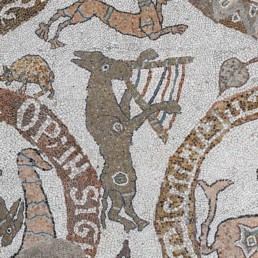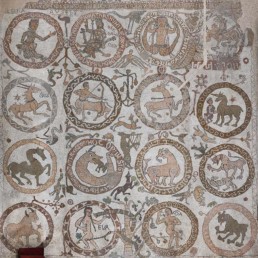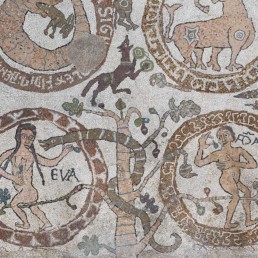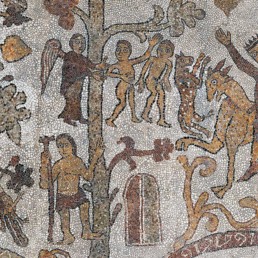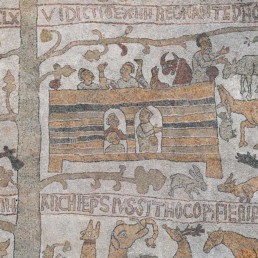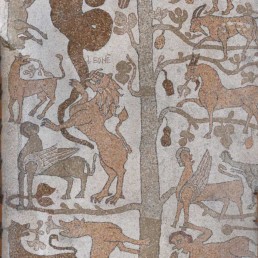Symbolism
The Story of Knowledge and the Love of God
A reading of the mosaic begins at the top, just as you would read a written text. The first page of this unique “stone book” is told in the quire, an area of the church reserved for the clergy. In the expansive mosaic that covers the presbytery and the apse, Pantaleone tells the story of Knowledge and the Love of God: he composes the very best music, just as in a musical score, and provides the note for the stave for reading the melodious notes.
The quire is the most holy part of the cathedral: here is the location of the Omphalos, the vital point of the building, the place of Incarnation, where Heaven and Earth unite in the Word of God.
The cathedral’s Omphalos is in centre of the sixteen clipei (a round Roman shield used for portraits), where Pantaleone depicts a prancing donkey playing a lyre, an iconographic subject that recalls the mythical figure of Orpheus, the talented musician who, with his kithara and enchanting music charmed animals and tamed even the wildest of beasts. This Classical myth reminds us that this young singer went down into the Underworld to bring back his beloved Eurydice to the world of the living. The donkey, a gentle and patient beast of burden, a common subject of Medieval art, is a symbol of Christ, whose melodies are able to touch the hearts of all and bring them back to life.
The sixteen circular medallions in the presbyter depict humans, animals and other of God’s creatures living in harmony, as symbolised by music. The balance and harmony enjoyed by Adam and Eve in Paradise, where all of God’s creature lived together in Nature, is interrupted by their disobedience.
With the Expulsion from Eden, the original perfection and the covenant with God is shattered.
Man, who has fallen to Earth, begins to measure things in time frames, as opposed to the eternal time of Paradise, as well as fatigue and difficulty, and a desire to return to the harmony and perfection lost. Man is therefore represented in the expanses of the mosaic in the central nave with his difficult attempt to ascend this majestic tree being a metaphor for life.
The cycle of Adam and Eve acts as an important connector between the stories presented in presbytery and those in the nave, where the mysterious and wise contents of the quire give way to the story depicted in the mosaic itself.
The small tree, which uniquely connects the two shields containing Adam and Eve and around the trunk of which the serpent of temptation is wrapped, joins together the narrative of these two parts of the church.
Reading from the sanctuary towards the nave, it is the Tree of Sin, the Tree of the Knowledge of Good and Evil from which Adam and Eve ate the forbidden fruit after listening to the Devil, who tempts them in the guise of a serpent.
On the other hand, reading from the nave towards the sanctuary, this small tree is the Tree of Life and Salvation: “And as Moses lifted up the serpent in the wilderness, even so must the Son of Man be lifted up” (John 3:14).
Going from the foliage down along the trunk, the mosaic tells the first events of Humanity: Adam and Eve are depicted as they are expelled from Eden, the gates of which are closed behind them, as they have the sinned in the form arrogance and pride before God. The difficulty of earthly life after the original sin is symbolised by the appearance of this great tree, with the lower part of the nave being filled with scenes of struggle surrounded by branches that are mostly withered and almost completely void of vegetation. The human condition on Earth, with its constant search for Truth and the meaning of life is told across the full expanse of the mosaic .The Biblical episodes of the construction of the Tower of Babel or the legend of the Flight of Alexander the Great also act as explicit warnings for the faithful who enter the cathedral to move away from pride and selfishness which make the journey more strained. Pantaleone’s message is clear: one cannot ascend to heaven through pride and arrogance, but only through Faith, Humility and Labour, values that refer to the biblical stories of Noah and the Cyle of the months, arranged at the top of the tree, where the foliage becomes visibly vibrant and lush.
In the Cycle of Noah, Noah, who was just a man, was able to save himself from the Flood by following divine instruction in the light of a renewed Covenant: he built an ark to save himself, his family and every living species of animal.
The topic of Labour, as an instrument of Salvation and Redemption, is explored in the twelve figures of the Calendar, where the signs of the Zodiac accompany men and women engaged in different agricultural and seasonal tasks, thereby respecting the cyclical nature of Nature and Time
Man, who during the Months lives according to God’s Wisdom, participates in what is narrated in the “sanctuary” (the presbytery and apse). In life, Man can therefore reach an equilibrium, even if it is different to the natural harmony experienced in Eden before the original sin, and this balance is depicted in the 16 medallions where creation lives in harmony and balance.
The homo viator, the pilgrim on this Earth, can thus only acknowledge the impossibility of reaching the top of the tree if they are driven by pride and arrogance, vice and sin, all of which have important allegories in the various stories and figures arranged around the lower trunk of the Tree.
The victory of the forces of Good over the force of Evil resumed in the apse, where the Resurrection of Christ and the salvific Mission of the Church is expressed in the biblical figures of the Prophet Jonah and Samson, who, by overcoming their human side, are prefigurations of Christ and Easter.
The History of Salvation continues in the mosaics in the transept, once again represented by smaller trees.
To the left, Pantaleone presents the extreme outcome of the battle in life between salvation (Paradise) and sin (Hell) to the faithful.
At the same time, the tree in the right transept contributes to this polyphonic narration of the great History of Salvation, with the victory of the Lion of Judah (Christ) over evil.



